Editorial: The Sky is Falling
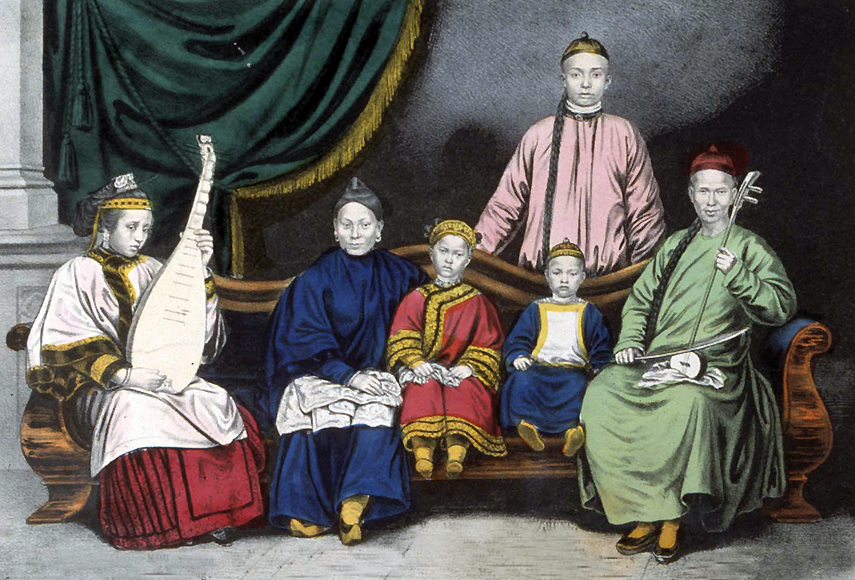
East Meets West
Pearl Buck's 1930 novel East Wind: West Wind tells the story of a wealthy, aristocratic Chinese family named Kwei which is being profoundly shaken by Western influences. Proud of its ancient lineage, the family is a rigidly hierarchical community, with separate men's and women's quarters: the head wife or First Lady presides over the women's sphere of concubines and female servants, and slaves, and the children of each; the husband and lord rules the men's sphere of older sons and male servants and slaves.
Kwei-lan, the story's narrator and a daughter of the First Lady and her lord, is married at age 17 to the man to whom she has been betrothed all her life, leaving her family to join his. She is confused and distressed when her new husband, who has managed to get an education in Western medicine, asks her to unbind her painfully-achieved tiny feet in which she took pride. But, trained to please and obey him, she decides to comply, undergoing the pain all over again. Other disorienting changes take place, such as his insistence that they move out of his parents' house into their own home because of his mother's contemptuous treatment of Kwei-lan, something the girl was trained never to complain about. She feels these events must displease the gods.
But over time, Kwei-lan finds herself liking her stronger feet and increased liberty, and takes an interest in the Western science that so absorbs him. She learns that China, the Middle Kingdom, is not as she was taught, the center of the world, but one country among many. As she learns, she begins to experience a greater closeness to her husband than her parents ever had. They have a son, her pride and joy, which the husband refuses to hand over to his parents as expected--another boon of her new liberty.
But much more seismic changes come when Kwei-lan's elder brother, the family's much-cherished heir, comes back from his studies in the United States refusing to marry his betrothed, who is a stranger to him, and bringing a Western woman named Mary whom he insists is already his wife, and dearly beloved. His mother is enraged and refuses to accept the "barbarian." His father, an irresponsible hedonist, seems to find Mary interesting and amusing. But when pressed, he finally tells his son to send his toy back to her country and do his duty to the family. A dreadful scene takes place between mother and son, with the son disowning his family. Kwei-lan loves her mother, is deeply distressed, and tries to comfort her, but is disregarded. Not long afterwards, the mother dies, apparently from grief and trauma. Kwei-lan is the only one who really mourns her. But in time, as she gains the friendship of her brother and Mary, she is increasingly consoled and fulfilled.
Readers will find it difficult to understand her filial love or sympathize with the First Lady, who is proud, dictatorial, rigid, and contemptuously xenophobic, caring little for her daughter, seemingly caring nothing for her cherished son's happiness but only for his dutiful submission and production of a legally recognized grandson. At one point, however, we get a glimpse into her soul: we see the deep hurt and resentment her husband's sexual self-indulgence, sanctioned by the culture, has caused. Her inner life is loveless, held together only by empty rewards: the commanding status of First Lady, achievement of a son who becomes a stranger, and hope for a grandson. When her son rejects her central value, and she loses both son and grandson at once, she lacks the courage and breadth of soul to look beyond the values she has always embraced. Her sky falls and crushes her.
The Sacred Canopy
This story of events in an alien culture has resonance to changes in our world today, and particularly to our movement on behalf of animals. Religion presides over two conflicting cultural processes: the shaping and support of structures of meaning, and the rejection of oppressive structures of meaning. Its function of supporting meaning is common; but the critique of oppression, unfortunately, is rather rare. Meaning is vital to humanness. We need to live in a world that makes sense, where some actions are good and others are bad: e.g., most people hold that cherishing one's children is good, abusing and killing them is bad. In the Confucian culture of the Kwei family, obeying one's parents and honoring one's family are good; disregarding both for personal benefits is bad. Similarly, in every culture some things are of greater value and other things of lesser or negative value: e.g., beautiful diamonds are valuable, beautiful soap bubbles are worthless; humans (in our own group) are valuable, animals are disposable. In the world of the Kwei, males are of much greater value than females, with the female infants of slaves being disposable. Religion undergirds the main factors in such worldviews.
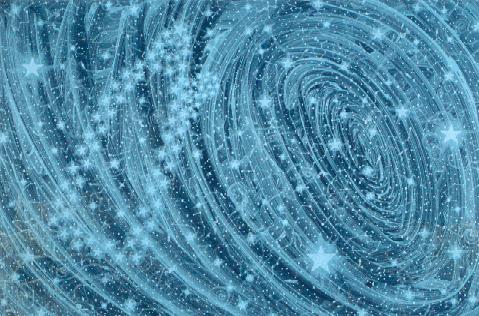
Sociologists tell us that we human beings acting together create our worlds of values, however firmly external they may seem. A good statement of this principle is found in Peter Berger's book The Sacred Canopy, "canopy" being used here in the metaphorical sense of the overarching sky, and beyond that, the conception of Heaven/Deity who authorizes the whole setup. Because it is a human creation, the world of values is subject to change and disintegration, and must be continually renewed by our conversations, our reaffirming language and actions. And, in turn, it shapes us, our values and intentions.
Collapse of the Canopy
Humans can deal with limited modification of these values; in fact some adventurous personalities tend to welcome change, whereas others resist most changes. The young tend to be more open than the old. But very few can deal with the permanent disintegration of the central structures of their world, even if it is an oppressive world; the soul withers. This usually happens to a whole culture when it is overridden by a very different culture, as, for example, Native American cultures when crushed by the European/American invasion. Of those who survive the physical violence, some individuals will quickly take refuge in the new worldview ("If you can't lick 'em, join 'em"); but many sink into anomie, manifesting in depression, poor health, and alcoholism or other addiction.
But this kind of whole-culture catastrophe is not the only way in which the sacred canopy falls; there is also a kind of internal anomie that can result from less drastic changes. When a growing minority (especially if it involves someone important to us) systematically overturns only one or two major values by word and deed, even if their new view is lifegiving, deep shudders of anxiety may be felt, harder to deal with for being poorly understood. Some examples: the Darwinian theory of evolution and new forms of Biblical scholarship had this effect on thousands of Protestant Christians in the nineteenth and early twentieth centuries; the changes in liturgy and practice in the Roman church sparked by the second Vatican Council of the 1960s had a similar effect on many Catholics. In both cases some benefited, finding the changes liberating; some maintained their old faith-world by a fundamentalist-type hardening of their beliefs. But others had to endure the sickening fall of their sky. One cannot always predict which values will be the crucial ones triggering internal anomie for a given person. Confusingly, even some who worked for and welcomed a liberating change may later experience the collapse; for example, there are Catholic clergy and nuns who rejoiced in the "opening of the windows" in their church but who later lost their faith. Clearly, there is much about human nature that still makes no sense by our present understanding.
In light of all this, it is helpful for us animal defenders to realize the extent of the threat that our message represents to many in the audience we seek to reach. If we see resistance only as stemming from a selfish clinging to favorite tastes, we will be more tempted to judgmentalism: how can supposedly decent people, for so trivial a reason, continue to support such a horrifying and evil system? But it may well be that they are sensing the approach of the worldquake that might result for them. Of course that does not excuse them from choosing continued numbness and violence over awakening and compassion. But it helps us to know what they are up against; and it may help us reassure them from our own experience.
A Sky Beyond
There is good news for those who courageously take the leap, yet later find that it leads to catastrophe: anomie is not necessarily fatal to the soul. One 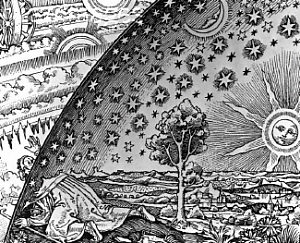 can recover. Those who lose their faith can regain it, finding a far wider sky that existed beyond the fallen canopy. (Peter Berger hints at this sky in his later book A Rumor of Angels.) Native Americans have recovered themes from their tradition, such as deep human interdependence with the earth, and combined them with concepts from Western spirituality and ecology, thus gaining the blessing of a worldview richer than either alone. Literalist Protestants who found themselves derelict on a desert of meaninglessness after losing a God who dictated the Bible word-for-word have gained a vastly larger (if more elusive) God in a vastly larger world.
can recover. Those who lose their faith can regain it, finding a far wider sky that existed beyond the fallen canopy. (Peter Berger hints at this sky in his later book A Rumor of Angels.) Native Americans have recovered themes from their tradition, such as deep human interdependence with the earth, and combined them with concepts from Western spirituality and ecology, thus gaining the blessing of a worldview richer than either alone. Literalist Protestants who found themselves derelict on a desert of meaninglessness after losing a God who dictated the Bible word-for-word have gained a vastly larger (if more elusive) God in a vastly larger world.
A wise example from fiction is found in George Eliot's classic novel Silas Marner, which has been mentioned before in PT. The story tells of the eponymous hero's loss of faith after his best friend framed him for a crime, and his narrow, simple religious faith failed to clear him. After fifteen years of spiritual darkness and drought, Silas regains his faith in Providence and Unseen Love as a result of an apparently chance happening during Christmastide--an orphaned girl's toddling into his hut--and his own impulsive decision to become father and mother to her. Choosing to interpret our lives with faith, and to act with love, can help us to once again become whole persons in a human world, under a sacred canopy not altogether made by human minds.
--Gracia Fay Ellwood
Unset Gems
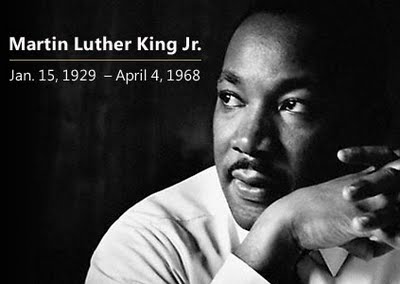 "Peace is not merely a distant goal that we seek but a means by which we arrive at the goal."
"Peace is not merely a distant goal that we seek but a means by which we arrive at the goal."
--Martin Luther King, Jr.
. . . [I]f someone told you that a particular corporation was trashing the air, water and soil; causing more global warming than the transportation industry; consuming massive amounts of fossil fuel; unleashing the cruelest sort of suffering on innocent and sentient beings; failing to recycle its waste; and clogging our arteries in the process, how would you react? Would you [keep consuming its products and] say, "Hey, that's personal?" --James E. McWilliams
--Contributed by Lorena Mucke
News Notes
Pigs are Smart
New findings on pig cognition have been published in the current issue of Animal Behaviour. Researchers present evidence that domestic pigs can quickly learn how mirrors work and will use their understanding of reflected images to scope out their surroundings and find their food. Also pigs have shown to be the quickest of animals to learn a new routine, from jumping hoops to play video games with joysticks, and more. Not surprisingly, they are also slow to forget. To read the full article see Pigs & Mirrors
Al Gore Getting Smarter
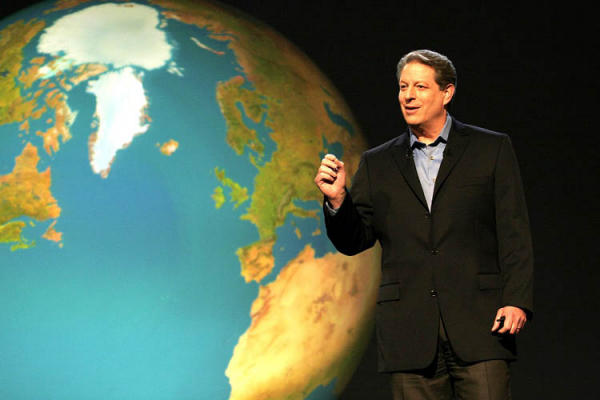 Former Vice President Albert Gore, who for years has done much to wake up the public to the looming environmental crisis, is finally acknowledging the connection between global warming and flesh eating. Speaking on NBC last November, Gore declared that he has cut down on meat, though he doesn't intend to become vegetarian. We can be grateful for this limited step, and keep hoping he will put his mouth altogether where his money is. See Al Gore
Former Vice President Albert Gore, who for years has done much to wake up the public to the looming environmental crisis, is finally acknowledging the connection between global warming and flesh eating. Speaking on NBC last November, Gore declared that he has cut down on meat, though he doesn't intend to become vegetarian. We can be grateful for this limited step, and keep hoping he will put his mouth altogether where his money is. See Al Gore
Letters
Dear Peaceable Friends,
I just read the December Peaceable Table & found this edition to be excellent. I especially like the piece about the history of Christmas in Europe. Christmas was not a national holiday in the newly established United States after the Revolutionary War. It was considered "too English," so it was only acknowledged in church. Probably those New Englanders had something to do with it: no presents, no tree, no Yule log, etc. Abraham Lincoln had a lot to do with bringing it back as an American celebration.
--Barbara Booth
Barbara Booth teaches history at Santa Ana College. For her Pilgrimage story in the January, '09 PT, see Barbara
http://www.vegetarianfriends.net/issue50.html
Dear Peaceable Friends,
. . . . I definitely did not know how close Christmas had come to extinction. Your contrast between animals as spiritually attuned beings and those things to be crushed or devoured was poignant . . .
I was raised Roman Catholic, so the review of The School of Compassion was very interesting to me. It just goes to show that men and women of higher thinking, from whatever school of thought, are all capable of finding the deep, powerful connection between humans and other species of life. I sent this review, as well as the review of Jane Goodall's book, to my sister. . . .
--Carl Sheppard
For Carl's Pilgrimage story in the May, '09 PT, see Carl
A Glimpse of the Peaceable Kingdom
Make Play, Not War
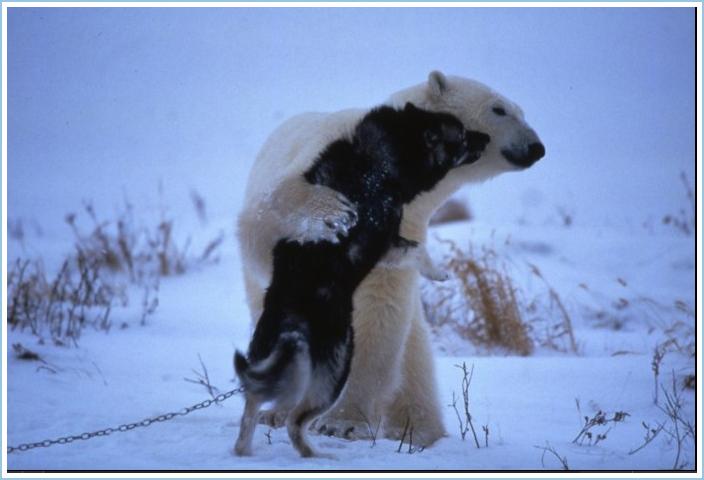
When German wildlife photographer Norbert Rosings, who has done extensive work with polar bears near Hudson's Bay, saw this bear approach the chained dogs, he thought for certain that there would be violence. But the bear only wanted to play! For other photos he took of these encounters (the bear returned every night for a week) see Rosings
--Contributed by Betse Streng and Maria Elena Nava
Book Review: The Vegan Table
The Vegan Table - 200 unforgettable recipes for entertaining every guest at every occasion. Colleen Patrick-Goudreau. Beverly, Massachusetts: Fair Winds Press. 304 pages. Paperback, $19.99. Illustrated .
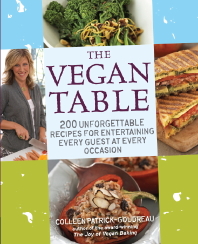 This amazing cookbook begins with a beautiful dedication, which reads in part: "May we have the sense of humor and liveliness of the goats, the maternal instincts and protective nature of the hens, and the sassiness of the roosters. May we have the gentleness and strength of the cattle, the wisdom, serenity and humility of the donkeys. May we appreciate the need for community as do the sheep and choose our companions as carefully as do the rabbits. May we have the faithfulness and commitment to family of the geese and the adaptability and affability of the ducks. May we have the intelligence, loyalty and affection of the pigs and the inquisitiveness, sensitivity and playfulness of the turkeys." Colleen follows these poetic words with an Introduction which is, in effect, her thumbnail autobiography. "I have taken after my mother," she avers. "I am an entertaining maniac. The only difference is that animals are on the guest list, not on the menu."
This amazing cookbook begins with a beautiful dedication, which reads in part: "May we have the sense of humor and liveliness of the goats, the maternal instincts and protective nature of the hens, and the sassiness of the roosters. May we have the gentleness and strength of the cattle, the wisdom, serenity and humility of the donkeys. May we appreciate the need for community as do the sheep and choose our companions as carefully as do the rabbits. May we have the faithfulness and commitment to family of the geese and the adaptability and affability of the ducks. May we have the intelligence, loyalty and affection of the pigs and the inquisitiveness, sensitivity and playfulness of the turkeys." Colleen follows these poetic words with an Introduction which is, in effect, her thumbnail autobiography. "I have taken after my mother," she avers. "I am an entertaining maniac. The only difference is that animals are on the guest list, not on the menu."
Chapter One is about meals for two - the vegan chef and a special loved someone. The chapter is subdivided into four menus, one for each season of the year. The spring menu includes steamed artichokes, a sauce for dipping the artichokes, a steamed veggie risotto, etc. The summer menu includes a bacon-substitute made from tempeh. In the autumn section we find a Moroccan stew that is free not only of animal products, but is also free of oil, soy and wheat--good news all around. One of the winter dishes is made of polenta (Italian for "coarse maize meal," but it is too delicious to call it that - at any rate, it is also wheat-free) shaped as squares, or hearts, or any shape you desire and can achieve.
The remaining chapters include menus to feed four, five, or six people; formal dining for six to ten people, and special occasions. Each chapter is subdivided into sections for each of the four seasons. Chapter Five is for holiday cooking, and has only two sections - spring is combined with summer, and autumn with winter. Chapter Six has foods for buffets, heavy appetizers, and finger food.
We strongly recommend this book to all who love to prepare and serve food, especially those who are compassionate and wish to create culinary masterpieces without harming the least of Christ's brothers and sisters / generating painful karma. However, those who (in the present stage of their life's journey) are primarily concerned about their own health rather than" the health of the chickens" will also derive great benefit from this first-class cookbook. It is full of attractive and tempting color photographs.
--Benjamin Urrutia
Children's Book Review:
That's Why We Don't Eat Animals: A Book About Vegans, Vegetarians, and All Living Things. Written and Illustrated by Ruby Roth. 2009. Hardcover. $16.95.

In this picture book, the stylized artwork (which might be seen as a hybrid of the styles of Hieronymus Bosch and Pablo Ruiz Picasso) occupies most of the reader's attention. Together with the text, it compares the lives of chickens, turkeys, quail, ducks, geese, pigs, cows, fish, and other animals who are allowed to do what they were created to do, with the horrible living deaths they suffer in the hellholes of factory farms and fishing nets. Both pictures and words are meant to be thought-provoking and conscience-awakening, but the extreme stylization means that they are not so shocking and scary that they will induce nightmares in little ones. Only the fish look indubitably like fish.
The intended audience is the children of vegans and vegetarians (and perhaps their friends), whose parents want them to eat with a conscience and to show compassion for our non-human neighbors who share Earth with us. We certainly recommend this book for just such an audience.
--Benjamin Urrutia
Recipes
Almond Ricotta Cheeze
makes 2 ½ cups
1 cup hot spring water
½ cup whole blanched almonds
1 cup cold spring water
1 T. fresh lemon juice
¼ cup cornstarch
1 T. canola or safflower oil
1 tsp. evaporated cane juice
½ tsp sea salt
Place hot water and almonds in blender, blend until smooth and not grainy. Add the rest of the ingredients, blend well again.
Pour into a small saucepan, stir constantly over medium-high heat until bubbly, reduce heat and cook one minute.
Scrape mixture into glass container. Allow to cool. Whisk or stir with fork to give texture of ricotta. Store in refrigerator.
Use as ricotta cheeze.
This recipe behaves just like conventional ricotta in recipes. It may be made ahead and stored in the refrigerator in a tightly covered glass container for about 1 week.
--Angela Suarez
Vegan Pastry Crust
Dough sufficient to make one 10-inch tart shell plus trimmings
1 cup organic unbleached flour
½ cup Earth Balance buttery substitute (1 stick)
¼ cup very cold spring water (start with 3 T. and add additional water, a little at a time)
In the bowl of a food processor, process flour and Earth Balance. Add water a little at a time until the dough forms a ball. Be careful not to add too much water or the dough will become sticky and will not be flaky when baked. Wrap dough in wax paper and allow to rest in the refrigerator or a cool place for at least 30 minutes. Roll out dough to fit 10 inch tart pan. Prick the bottom of the crust with tines of a fork; this prevents the crust from bubbling up during baking.
For a partially baked crust: Preheat oven 400° F. Line the crust with foil and add weights, such as beans. Bake for 15 minutes. Remove beans and bake for another 5 - 10 minutes. Then bake as directed for a recipe.
This pastry dough can be used for desserts or savory recipes. It is incredibly easy and amazingly flaky for a pastry dough made in a food processor.
--- Angela Suarez
My Pilgrimage: "Elmo"
by Ann-Marie Joiner
I was a meat-eater for more than twenty years. I grew up in a household with no pets, except for a budgie who died. I was always intrigued by cats and dogs, but was really scared of them, as my mother had been attacked by two Siamese cats. Since then, it was like the shroud of shame to have a cat or dog, or even to think about it.
Then, two years ago, I met the love of my life, Jason. He is as close as it comes to being a vegan, but he eats milk products and honey (eggs are excluded). His principle is not to hurt any other living thing, meaning he will eat honey because it doesn't harm the bees, but will not buy leather shoes or belts because a cow was murdered to produce them.
I was so impressed with the way he handled things--the criticism, the questions ("where do you get your protein?"), as well as the annoyed waitress giving that blank stare when asked "is this soup meat- or vegetable-based?" I am sure you can understand this if you have ever been in a similar situation. I had tried previously (alone) to become a vegetarian for health reasons, but peer pressure got me to cave in. Now that I have Jason, I can truly form a united front, including handling the peer pressure.
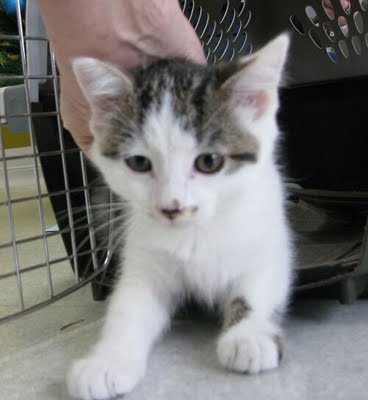 I slowly gave up red meat, then white. I still had not given up fish of all sorts--until I met Elmo, our gray and white tabby. He is the cutest, cuddliest cat I have ever seen. He was found in a dumpster in Prince Edward Island by my sister-in-law. She heard Elmo's meows of hunger and sickness, and took him home to join the multitude of other cats she has. Unfortunately, my sister-in-law's home is right next to the Trans-Canada Highway, and a lot of her pets have met their death. We were concerned that if we left Elmo there, his days would be numbered, so we drove him fourteen hours to be with us at home in Montreal.
I slowly gave up red meat, then white. I still had not given up fish of all sorts--until I met Elmo, our gray and white tabby. He is the cutest, cuddliest cat I have ever seen. He was found in a dumpster in Prince Edward Island by my sister-in-law. She heard Elmo's meows of hunger and sickness, and took him home to join the multitude of other cats she has. Unfortunately, my sister-in-law's home is right next to the Trans-Canada Highway, and a lot of her pets have met their death. We were concerned that if we left Elmo there, his days would be numbered, so we drove him fourteen hours to be with us at home in Montreal.
Elmo was so small, he could fit into the palm of my hand. The vet said that he was so sickly that he might not even make the ride home, because he had starved for too long, had lice, mites, and a heart murmur. The vet suggested we leave him, so as not to get attached. What the vet didn't know was that I already was. When I saw that helpless face, and the need to cuddle and make a home, I knew I couldn't continue to eat animals, especially such cute and cuddly ones as Elmo.
This is the day I gave up meat forever. I am so glad I made that decision. A few months ago, we got Elmo a girlfriend, Shyla, a petite black cat, from the Animal Rescue Network, a non-profit, no-kill animal shelter in Montreal. There are many other pets waiting for a home, and I encourage you to visit your local shelter to adopt them.
Reprinted from Voices from the Garden, Lantern Books, 2001, by permission of the editors Sharon and Daniel Towns. The kitten picture is from the website of an Oregon resident who calls herself "Catwoman," who finds homes for cats in need.
Poetry: Beatitudes for a New Era
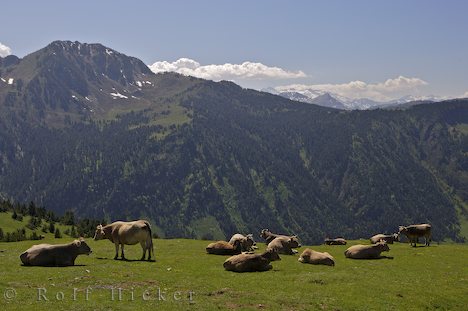
Blessed are the cows;
They shall lie down in green pastures.
Blessed are the calves;
They shall nurse in love.
Blessed are the pigs;
They shall snuggle together in peace.
Blessed are the hens;
They shall gather their chicks under their wings.
Self-cursed are those who slash forests for "beef" pastures;
Their land lies waste and desolate.
Kyrie eleison
Self-cursed are those who steal milk out of the mouths of calves;
Many die of wasting disease.
Christe eleison
Self-cursed are those who kill and eat the pigs;
They grow sick at heart.
Kyrie eleison
Blessed are those who refuse the gory dish;
They feast in the Kingdom of God.
Blessed are the merciful;
Mercy is shown to them.
Blessed are those who love their enemies;
They have a world of friends.
Blessed are those who seek the Light in every face:
They shall see God.
--Sr. Faith Bowman, O.C.G.
The photo, by Rolf Hicker, depicts a pasture in the Pyrenees, Catalonia, Spain. See http://www.hickerphoto.com .
Dust of Snow
The way a crow
Shook down on me
The dust of snow
From a hemlock tree
Has given my heart
A change of mood
And saved some part
Of a day I had rued
--Robert Frost
The Peaceable Table is
a project of the Animal Kinship Committee of Orange Grove Friends Meeting, Pasadena, California. It is intended to resume the witness of that excellent vehicle of the Friends
Vegetarian Society of North America, The Friendly
Vegetarian, which appeared quarterly between 1982 and
1995. Following its example, and sometimes borrowing from its
treasures, we publish articles for toe-in-the-water
vegetarians as well as long-term ones.
The journal is intended to be
interactive; contributions, including illustrations, are
invited for the next issue. Deadline for the February issue
will be Jan. 28, 2010. Send to graciafay@gmail.com
or 10 Krotona Hill, Ojai, CA 93023. We operate primarily
online in order to conserve trees and labor, but hard copy
is available for interested persons who are not online.
The latter are asked, if their funds permit, to donate $12 (USD) per year. Other
donations to offset the cost of advertising (in The Christian Century) are welcome.
Website: www.vegetarianfriends.net
Editor: Gracia Fay Ellwood
Book and Film Reviewers: Benjamin Urrutia & Robert Ellwood
Recipe Editor: Angela Suarez
NewsNotes Editors: Lorena Mucke and Marian Hussenbux
Technical Architect: Richard Scott Lancelot Ellwood


 can recover. Those who lose their faith can regain it, finding a far wider sky that existed beyond the fallen canopy. (Peter Berger hints at this sky in his later book A Rumor of Angels.) Native Americans have recovered themes from their tradition, such as deep human interdependence with the earth, and combined them with concepts from Western spirituality and ecology, thus gaining the blessing of a worldview richer than either alone. Literalist Protestants who found themselves derelict on a desert of meaninglessness after losing a God who dictated the Bible word-for-word have gained a vastly larger (if more elusive) God in a vastly larger world.
can recover. Those who lose their faith can regain it, finding a far wider sky that existed beyond the fallen canopy. (Peter Berger hints at this sky in his later book A Rumor of Angels.) Native Americans have recovered themes from their tradition, such as deep human interdependence with the earth, and combined them with concepts from Western spirituality and ecology, thus gaining the blessing of a worldview richer than either alone. Literalist Protestants who found themselves derelict on a desert of meaninglessness after losing a God who dictated the Bible word-for-word have gained a vastly larger (if more elusive) God in a vastly larger world. "Peace is not merely a distant goal that we seek but a means by which we arrive at the goal."
"Peace is not merely a distant goal that we seek but a means by which we arrive at the goal."
 Former Vice President Albert Gore, who for years has done much to wake up the public to the looming environmental crisis, is finally acknowledging the connection between global warming and flesh eating. Speaking on NBC last November, Gore declared that he has cut down on meat, though he doesn't intend to become vegetarian. We can be grateful for this limited step, and keep hoping he will put his mouth altogether where his money is. See
Former Vice President Albert Gore, who for years has done much to wake up the public to the looming environmental crisis, is finally acknowledging the connection between global warming and flesh eating. Speaking on NBC last November, Gore declared that he has cut down on meat, though he doesn't intend to become vegetarian. We can be grateful for this limited step, and keep hoping he will put his mouth altogether where his money is. See 
 This amazing cookbook begins with a beautiful dedication, which reads in part: "May we have the sense of humor and liveliness of the goats, the maternal instincts and protective nature of the hens, and the sassiness of the roosters. May we have the gentleness and strength of the cattle, the wisdom, serenity and humility of the donkeys. May we appreciate the need for community as do the sheep and choose our companions as carefully as do the rabbits. May we have the faithfulness and commitment to family of the geese and the adaptability and affability of the ducks. May we have the intelligence, loyalty and affection of the pigs and the inquisitiveness, sensitivity and playfulness of the turkeys." Colleen follows these poetic words with an Introduction which is, in effect, her thumbnail autobiography. "I have taken after my mother," she avers. "I am an entertaining maniac. The only difference is that animals are on the guest list, not on the menu."
This amazing cookbook begins with a beautiful dedication, which reads in part: "May we have the sense of humor and liveliness of the goats, the maternal instincts and protective nature of the hens, and the sassiness of the roosters. May we have the gentleness and strength of the cattle, the wisdom, serenity and humility of the donkeys. May we appreciate the need for community as do the sheep and choose our companions as carefully as do the rabbits. May we have the faithfulness and commitment to family of the geese and the adaptability and affability of the ducks. May we have the intelligence, loyalty and affection of the pigs and the inquisitiveness, sensitivity and playfulness of the turkeys." Colleen follows these poetic words with an Introduction which is, in effect, her thumbnail autobiography. "I have taken after my mother," she avers. "I am an entertaining maniac. The only difference is that animals are on the guest list, not on the menu."
 I slowly gave up red meat, then white. I still had not given up fish of all sorts--until I met Elmo, our gray and white tabby. He is the cutest, cuddliest cat I have ever seen. He was found in a dumpster in Prince Edward Island by my sister-in-law. She heard Elmo's meows of hunger and sickness, and took him home to join the multitude of other cats she has. Unfortunately, my sister-in-law's home is right next to the Trans-Canada Highway, and a lot of her pets have met their death. We were concerned that if we left Elmo there, his days would be numbered, so we drove him fourteen hours to be with us at home in Montreal.
I slowly gave up red meat, then white. I still had not given up fish of all sorts--until I met Elmo, our gray and white tabby. He is the cutest, cuddliest cat I have ever seen. He was found in a dumpster in Prince Edward Island by my sister-in-law. She heard Elmo's meows of hunger and sickness, and took him home to join the multitude of other cats she has. Unfortunately, my sister-in-law's home is right next to the Trans-Canada Highway, and a lot of her pets have met their death. We were concerned that if we left Elmo there, his days would be numbered, so we drove him fourteen hours to be with us at home in Montreal.